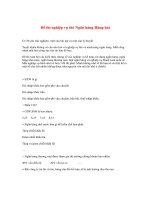adrenal suppression craig s. miller, dmd, ms
Bạn đang xem bản rút gọn của tài liệu. Xem và tải ngay bản đầy đủ của tài liệu tại đây (2.04 MB, 49 trang )
Adrenal Insufficiency
Craig S. Miller, DMD, MS
ENDOCRINE DISEASE: comes in many
forms. Simplistically, there are disorders
that cause over- or under-production
hormones for the affected gland.
Pituitarism (HYPO-, HYPER)
Diabetes mellitus, insipidus
Thyroidism (HYPO-, HYPER)
Adrenalism (HYPO-, HYPER)
Parathyroidism (HYPO-, HYPER)
Renal disease (erythropoetin)
Ovaries, testes (gonadal-related hormones)
The pituitary gland is the master regulator of most endocrine glands. It
receives signals from the hypothalamus and sends signals to the target
(endocrine) organ by secreting hormones. These in effect modulate the
production of the target glandular organ.
Adrenal Gland
This powerpoint presentation focuses
primarily on normal adrenal cortical function
and hypofunction.
The adrenal gland secretes several hormones
from either the adrenal cortex or adrenal
medulla (see Box 15-1 in the text).
Adrenal Cortex (located around the
medulla)
The adrenal cortex
consists of 3 zones (zona
glomerulosa [ZG], zona
fasciculata [ZF] and zona
reticularis [ZR]) which
secrete gluocorticoids,
mineralocorticoids and
androgens.
Cholesterol is the
precursor molecule for
these hormones.
Pheochromocytoma
Adapted from Fig. 16-22 page 507 of Anatomy & Physiology 5
th
ed Thibodeau GA, Patton KT
Main
secretory
product
Aldosterone
Cortisol
Androgens
Epinephrine
Norepinephri
ne
Action
Regulates salt and water
balance by affecting renal
distal tubules
Anti-inflammatory, decrease
bone formation, decrease
muscle mass, increase blood
glucose, increase glomerular
filtration, modulate emotions
Sexual maturation
Increase
cardiac output
Increase
arterial
pressure,
increase
peripheral
resistance
Regulation
Secretion of cortisol is
regulation by ACTH (on right)
and circadian rhythm (see
below).
“Biological Clock” normal pattern
Normal secretion rate of cortisol over a 24-hour
period is approximately 20 mg
Regulation
Secretion of
aldosterone is less
dependent of the pituitary
gland. It is regulated by
angiotensin II which
receives signals primarily
from salt and water
balance and blood
pressure sensors in the
kidney.
Biological Effects of Cortisol
Breakdown of protein
Suppress ACTH synthesis
Anti-inflammatory
blocks endothelial cell
expression of I/ECAM
Enzyme induction
Hematopoeisis
Fat deposition
Enhances appetite
Maintain muscular work
Reduction of eosinophils
Gluconeogenesis
Liver glycogen deposition
Uric acid excretion
Water excretion
Growth inhibition
Elevation of blood glucose
Effect of cortisol is antagonistic to insulin. Cortisol pushes glucose into the
bloodstream, whereas insulin works to store glucose in fat cells and muscle.
Cortisol is released during stress which releases glucose into the bloodstream so if
the stress is a physical threat (eg., lion, tiger or bear), you have the necessary sugar
in your bloodstream to run away.
ADRENAL DISEASE
TYPES
HYPOFUNCTION (see next slide)
HYPERFUNCTION
Example on right shows enlarged adrenal gland (top)
compared to normal (bottom). This condition causes many
problems, but most do not pose a great risk to the practice of
dentistry on these patients.
BENIGN TUMOR: Adenoma
MALIGNANT TUMOR: Carcinoma. The
destruction can lead to hypofunction.
These are not discussed in this
presentation.
Types of Adrenal Insufficiency
(Hypofunction)
** Primary - glucocorticoid & mineralocorticoid
deficiency due to destruction or atrophy of the gland.
Also known as Addison’s Disease.
Secondary – due to reduced pituitary function
- Cushing’s syndrome (due to prolonged steroid use)
** Adrenal Crisis
** Indicates greater risk of adverse event
Epidemiology
5% of adults in USA chronically use corticosteroids and are at
risk of secondary adrenocortical insufficiency (hypofunction).
This type is more common than Addison’s disease.
Addison’s disease occurs at a rate of 8 cases per million people
per year. In the population of Kentucky 2-3 million, one can
expect about 2 cases developing per year.
Adrenal insufficiency attributed to all causes occurs in about 40-
60 persons per million.
Thus, a dental practice serving 2000 adults can expect to
encounter about 40-50 patients who chronically use steroids or
have potential adrenal abnormalities.
Causes Primary Adrenal Insufficiency
Autoimmune disease
Tuberculosis
Hemorrhage
Neoplasia
Infection (Fungal, TB, HIV, CMV)
Sepsis
Hemochromatosis
Drugs
Adrenalectomy
Addison’s Disease
Features: anorexia, weakness,
weight loss, nausea,
salt craving
hyperpigmentation of frictional
surfaces and mucosa
hypotension, hyponatremia,
hypovolemia,
Primary Adrenal Insufficiency
(Addison’s Disease)
Labs: hyponatremia, hyperkalemia,
elevated BUN, low serum glucose, mild
anemia
Therapy: glucocorticoid and
mineralocorticoid
Etiologic and Clinical Findings in
Secondary Adrenal Insufficiency
Causes Cushing’s disease: pituitary tumor, pituitary
infarction, pituitary infiltrative disease, meningitis,
encephalitis, pituitary irradiation
Causes Cushing’s syndrome: steroid use and
withdrawal
Features: Less dramatic features, No
hyperpigmentation, normal blood volume, pituitary
disease
For Patients who take Steroids:
Need to know:
Why they take a steroid medication?
What type of steroids they take?
How potent is the steroid?
How long have they taken it?
Do they have adrenal suppression because of their
medication?
To accurately determine if they are suppressed, you
may need to order an cortisol stimulation test to
determine their degree of suppression and ability to
respond to stress.
Therapeutic Uses of Steroids
Arthritis
Rheumatic carditis
Renal disease
Collagen diseases
Allergic diseases
Bronchial asthma
Organ transplant
Ocular disease
Skin disease
GI disease
Malignancies
Diseases of liver
Sarcoidosis
Thrombocytopenia
Cortisol (Solu-cortef) 20 +2
Prednisone (Deltasone) 5 +1
Methylprednisolone 4 0
(Medrol)
Triamcinolone (Kenalog) 4 0
Dexamethasone 0.75 0
(Decadron)
Betamethasone 0.6 0
(Celestone)
8-12 hr
18-36
18-36
18-36
36-54
36-54
Drug Dose Na+/H20 Half-life
More potent
Less potent
Taking steroids on an alternate-day regimen causes less adrenal suppression than daily dosing.
Cortisone 30 mg daily = prednisone 7.5 mg daily
Topical Steroid Ointments
Ultra-high potency
clobetasol 0.05%
High potency
fluocinonide 0.05%, halcinonide 0.1%, dexamethasone elixir
0.5 mg/5 mL swish and swallow
Moderate potency
triamcinolone 0.5%, betamethasone dipropionate 0.05%
Low potency
traimcinolone 0.01%,
betamethasone valerate 0.01%
(Generally do not cause adrenal suppression. Exception ultra-high
potency drugs used for long periods over large areas of the body,
especially if occlusive dressing are used)
Inhaled Steroids
Generally do not cause adrenal suppression.
The vast majority of patients treated with
conventional doses of inhaled steroids have
no clinically relevant systemic steroid effects.
Daily doses above 1000 to 1500 mg/day (in
four divided doses) of beclomethasone
dipropionate or budesonide in adults
(depending on body mass) generally are
considered to be the cutoff point, indicating
adrenal suppression is probable.
Adverse Effects with Steroid Use
Candidiasis
Cushinoid changes (fluid retention, weight gain, moon “puffy”
facies), rounding of the back “buffalo hump”
Obesity, glucose intolerance, diabetes, hypertension
Mood changes - aggressiveness - insomnia - depression -
acute psychosis
Prednisone
Features of Cushing’s
Syndrome
Acne, bruisability, gastritis and GI
bleeding, cataracts
Osteoporosis, vertebral fractures
Growth retardation in children,
myopathy - weakness
Adverse Effects with Steroid Use
(continued)









